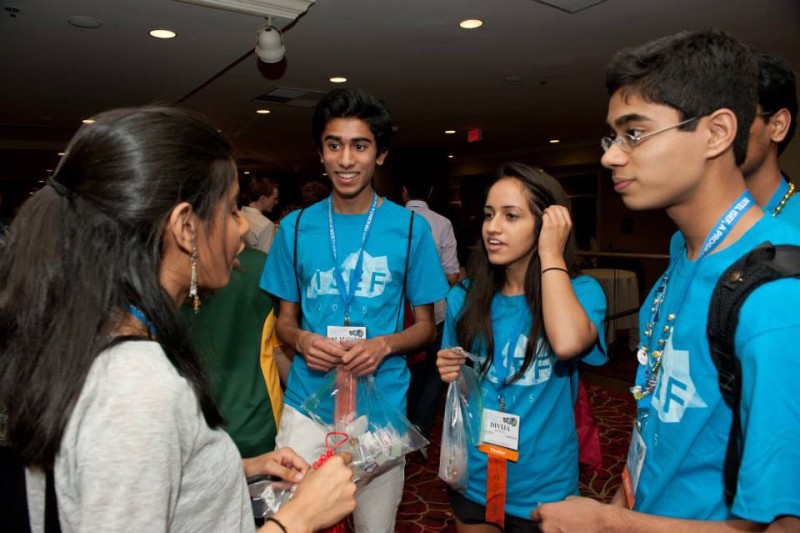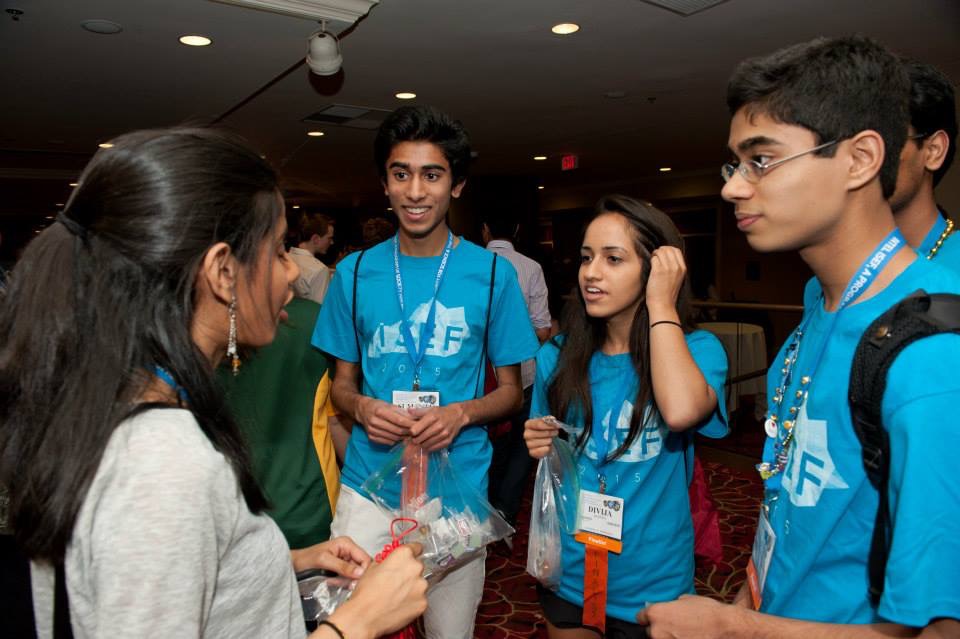
Fourteen Manual students competed at the Intel International Science and Engineering Fair (ISEF) in Pittsburgh from May 10 to May 15.
Five of the eleven Manual projects represented at the fair earned top awards.
The team of Sophia Korner (10, MST) and Diya Mathur (10, MST) placed first in the Behavioral and Social Sciences category for their project, “The Effect of Shape, Weight, and Diameter on Haptic Perception: An Active Haptic Sensing Study of the Predicted and Actual Grip Forces and their Impacts on Weight Detection Thresholds.”
“Essentially what we did this year was engineer, design and program a force sensing glove that could measure the amount of force applied to help us better research perception and different weight illusions,” Mathur said. “One thing we found was that most people underestimate the amount of force needed to lift an object and so prosthetic and motor assist arm users, for example, can often drop objects because of this inaccuracy in prediction.”
Korner and Mathur also won a first place special award from the American Intellectual Property Law Association, a third place special award from the National Aeronautics and Space Association and the ISEF Cultural and Scientific to China Award.
“To be considered to win the Cultural and Scientific Visit to China Award, one must be within the top 20 projects from the entire international fair,” Mathur said. “This is such an honor because this is one of those moments where you truly realize that the sky’s the limit and nothing is impossible, even as a high school student.”
Sanjana Rane (11, MST) placed second in the Biochemistry category for her project, “The Role of Extracellular Nuclear Factor-Erythroid Derived Protein 2 (NF-E2) as a Danger Associated Molecular Pattern (DAMP) Released during Acrolein Induced Renal Fibrosis.” Rane also won a $1,000 first place special award from the Ashtavadhani Vidwan Ambati Subbaraya Chetty Foundation.
“For the past couple of years, I’ve been studying how environmental pollutants affect our body,” she said. “Last year I discovered that this one chemical, Acrolein, was actually promoting renal fibrosis. In addition to that, I discovered that Acrolein was modulating the expression of this particular protein inside and outside renal cells. This year, I was evaluating the role of that protein in promoting fibrosis and inflammation, the two aspects of renal fibrosis, in order to explore its potential as a therapeutic target to treat renal disease.”
Rane’s favorite part of the science fair experience was connecting with students from around the world.
“Since I’ve been luckily enough to have been to ISEF before, I have made many friends with whom I still keep in contact,” she said. “Meeting up with them and spending time with them was probably my favorite part, as it’s nice to hear what your friends have been doing since the last time we met.”
Sumanth Chennareddy (11, MST) placed fourth in the Biomedical and Health Sciences category for his project, “Characterization of Vascular Responses to Mechanically Induced Continuous Flow Patterns in Bovine Models.”
“I was a little bit surprised that I won a grand award in my category because I felt that my final judging interview didn’t go as well as it could have,” Chennareddy said. “I did feel that some of my category judging interviews compensated for that.”
Rane and Chennareddy earned second and third place special awards, respectively, from the American Physiological Society.
Mukund Venkatakrishnan (10, MST) placed third in the Embedded Systems category for his project, “Development of a Ultra Low-Cost Integrated Audiometer and Hearing Aid.” Venkatakrishnan also won a $500 second place special award from the Acoustical Society of America.
The team of Madan Subheeswar (11, MST), Richard Gunasena (11, MST) and Matthew Raj (10, MST) placed third in the Energy: Chemical category.
“This year, my partners and I focused on a form of energy storage technology known as capacitors,” Subheeswar said. “Capacitors are known for their extremely high rates of energy discharge, but have a low energy capacity. Therefore, by combining two principles of supercapacitors, electric double-layer capacitance and pseudocapacitance, we were able to create a capacitor with a 500% increase in energy capacity, allowing for capacitors that are more compact, lighter and less impactful on the environment, all while maintaining performance.”
Subheeswar enjoyed the opportunity to participate in activities outside of the competitive sessions.
“Outside of the actual fair, I was able to socialize with ISEF Finalists from schools in Kentucky, the United States and even around the world,” he said. “There were activities that were arranged by the fair as well as excursions that I took as part of Kentucky’s delegation. For example, I attended a pin exchange where I mingled with peers from around the world, watched the Ohio River form at the confluence point of the Monongahela and Allegheny Rivers, observed Pittsburgh’s beautiful cityscape from the surrounding hills, toured the Pittsburgh Steelers’ Heinz Field and visited the Pittsburgh Science Center.”
ISEF category awards were accompanied by cash prizes of $5,000 for first place winners, $1,500 for second place winners, $1,000 for third place winners and $500 for fourth place winners.
Jennifer Leung (11, MST), Emily Liu (10, MST), Sasank Vishnubhatla (11, MST), Akanksha Gupta (11, MST), Divija Sharma (11, MST) and Harsha Paladugu (10, MST) also represented Manual at the fair. Students qualified to ISEF by earning top honors at either the regional or state competitions.
A complete list of ISEF Grand Award winners can be found here, and a list of special award winners can be found here. Click here to meet some of this year’s ISEF competitors and to learn more about the specifics of their research.




